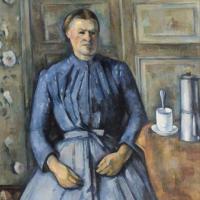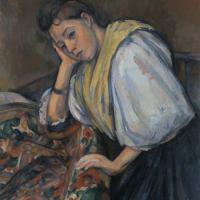Paul Cezanne
Woman With A Coffeepot
$450.00
Paul Cezanne
Paul Cezanne (1839-1906)
Paul Cézanne (19 January 1839 – 22 October 1906) was a French artist and Post-Impressionist painter whose work laid the foundations of the transition from the 19th-century conception of artistic endeavor to a new and radically different world of art in the 20th century. Cézanne's often repetitive, exploratory brushstrokes are highly characteristic and clearly recognizable. He used planes of colour and small brushstrokes that build up to form complex fields. The paintings convey Cézanne's intense study of his subjects.
Cézanne is said to have formed the bridge between late 19th-century Impressionism and the early 20th century's new line of artistic enquiry, Cubism. Both Matisse and Picasso are said to have remarked that Cézanne "is the father of us all."
Cézanne's works were rejected numerous times by the official Salon in Paris and ridiculed by art critics when exhibited with the Impressionists. Yet during his lifetime Cézanne was considered a master by younger artists who visited his studio in Aix.
Along with the work of Vincent van Gogh and Paul Gauguin, the work of Cézanne, with its sense of immediacy and incompletion, critically influenced Matisse and others prior to Fauvism and Expressionism.[51][52] After Cézanne died in 1906, his paintings were exhibited in a large museum-like retrospective in Paris, September 1907. The 1907 Cézanne retrospective at the Salon d'Automne greatly affected the direction that the avant-garde in Paris took, lending credence to his position as one of the most influential artists of the 19th century and to the advent of Cubism.
Cézanne's explorations of geometric simplification and optical phenomena inspired Picasso, Braque, Metzinger, Gleizes, Grisand others to experiment with ever more complex views of the same subject and eventually to the fracturing of form. Cézanne thus sparked one of the most revolutionary areas of artistic enquiry of the 20th century, one which was to affect profoundly the development of modern art. Picasso referred to Cézanne as "the father of us all" and claimed him as "my one and only master!" Other painters such as Edgar Degas, Pierre-Auguste Renoir, Paul Gauguin, Kasimir Malevich, Georges Rouault, Paul Klee, and Henri Matisse acknowledged Cézanne's genius.
A prize in his memory, called the Cézanne medal, is granted by the city of Aix en Provence, in France for special achievement in the arts.
Cézanne's painting The Boy in the Red Vest was stolen from a Swiss museum in 2008. It was recovered in a Serbian police raid in 2012.
The 2016 film Cézanne and I explores the friendship between the artist and Émile Zola.
On 10 May 1999, Cézanne's painting Rideau, Cruchon et Compotier sold for $60.5 million, the fourth-highest price paid for a painting up to that time. As of 2006, it was the most expensivestill life ever sold at an auction. One of Cézanne's The Card Players was sold in 2011 to the Royal Family of Qatar for a price variously estimated at between $250 million ($278.4 million today) and possibly as high as $300 million ($334.1 million today), either price signifying a new mark for highest price for a painting; surpassed only by Leonardo da Vinci's Salvator Mundi in November 2017.




